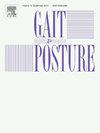Changes in time-continuous joint kinematics in preschool children over the stance phase of gait
IF 2.2
3区 医学
Q3 NEUROSCIENCES
引用次数: 0
Abstract
Background
The use of statistical parameter mapping (SPM) to compare gait kinematics of children at different ages seems to be a more appropriate tool to describe the differences than simply describing the maxima and minima on the curves.
Research question
Does lower limb kinematic waveforms differ during gait in normally developing preschool children?
Methods
In a cross-sectional study, SPM was used to compare kinematic waveforms of typically developing preschool children at ages 2, 3, and 6 years (n = 42).
Results
Differences in internal rotation foot angle between 2-year-olds and 3-, 6-year-olds in 22–55 % lower in 2-year-olds but 85–100 % greater in 2-year-olds. Greater internal rotation of the knee in 2-year-olds versus 6-year-olds in 13–25 % of the stance phase. Lower knee abduction in 2-year-olds versus 6-year-olds in the first 13 % of the stance phase.
Significance
Comparison of the waveforms of the angle may provide a clearer understanding of the differences in gait kinematics in children at different ages.
学龄前儿童在步态的站立阶段时间连续关节运动学的变化
背景使用统计参数图谱(SPM)比较不同年龄儿童的步态运动学似乎比简单描述曲线上的最大值和最小值更适合描述差异。方法在一项横断面研究中,使用 SPM 对 2、3 和 6 岁发育正常的学龄前儿童(n = 42)的运动波形进行比较。结果2 岁儿童和 3、6 岁儿童的足内旋角差异为:2 岁儿童低 22-55%,但 2 岁儿童高 85-100%。在 13-25% 的站立阶段,2 岁儿童的膝关节内旋角度大于 6 岁儿童。在站立阶段的前 13%,2 岁儿童的膝外展比 6 岁儿童的低。
本文章由计算机程序翻译,如有差异,请以英文原文为准。
求助全文
约1分钟内获得全文
求助全文
来源期刊

Gait & posture
医学-神经科学
CiteScore
4.70
自引率
12.50%
发文量
616
审稿时长
6 months
期刊介绍:
Gait & Posture is a vehicle for the publication of up-to-date basic and clinical research on all aspects of locomotion and balance.
The topics covered include: Techniques for the measurement of gait and posture, and the standardization of results presentation; Studies of normal and pathological gait; Treatment of gait and postural abnormalities; Biomechanical and theoretical approaches to gait and posture; Mathematical models of joint and muscle mechanics; Neurological and musculoskeletal function in gait and posture; The evolution of upright posture and bipedal locomotion; Adaptations of carrying loads, walking on uneven surfaces, climbing stairs etc; spinal biomechanics only if they are directly related to gait and/or posture and are of general interest to our readers; The effect of aging and development on gait and posture; Psychological and cultural aspects of gait; Patient education.
 求助内容:
求助内容: 应助结果提醒方式:
应助结果提醒方式:


